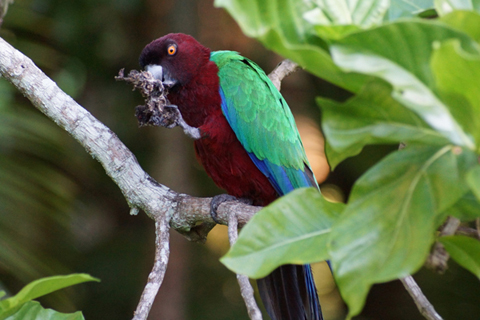The sounds of domestic animals was now replaced with the more melodic chirping of birds, and waves gently lapping on the beach outside our fale on Fafa Island.
Fale is the Samoan word for house, however it is widely used in other parts of Polynesia.
The fales all have names and ours was called Niu, which means coconut in Tongan.
It was set in a secluded tropical garden surrounded by palms. We had our own private beach with two sun lounges. There were also more sun lounges in the garden and on the veranda, and a large hammock, hanging in the shade.
There was certainly no shortage of places to do absolutely nothing – which is what we did for most of the time.
The quiet was broken briefly on Saturday morning when a boat load of Chinese tourists arrived from the mainland for a day trip.
The Kingdom of Tonga has 176 Islands scattered over an area of 700,000 square kilometers of the South Pacific.
Only 52 islands are inhabited and Fafa is one.
This idyllic Robinson Crusoe style island is only 17 acres in size and dotted with coconut palms and surrounded by sandy beaches and coral reefs.
Fafa was developed in 1982 by Rainer Urtel, a German hippy, who fell in love with the Island.
Now in his 70s he still comes every year, for two months, to manage the property. For the rest of the year two other couples take over. Heidi and Martin, from Austria, were currently in charge. Heidi has been working on Fafa for the last ten years and other members of staff had been there that long as well.
She told us that she had tried to escape the island a few years ago but its magnetic charms drew her back.
At low tide you can circumnavigate Fafa. It only takes about 30 minutes and that’s with plenty of time to take some snaps.
When the tide is high there is a bush trail that runs through the eastern part. This section of Fafa is uninhabited and again only takes a short time to explore.
Bird life is everywhere and come dawn the squeak, squawk and screeching of the locals is deafening.
There are even some rather rare Fijian parrots, that were originally brought to Tonga for their feathers but now roam freely around the island.
One afternoon we spent a pleasant couple of hours snorkelling on a reef that was closer to the main island. The coral wasn’t great but there was a good variety of fish.
Our boatman, Moses, had great fun getting the some members of the group back into the boat, after the snorkelling.
He claimed that the boat’s ladder had been stolen, but I think he enjoyed the entertainment too much.
On our last day, the usual morning chorus was interrupted by a sudden downpour. It didn’t last long, however the weather had changed and it was a lot cooler.
This didn’t stop us having another snorkel, this time off the beach, in front of our fale. There were fewer fish but the coral was much better.
Fafa was made a Marine Preserve in 2013. This has already helped to protect the coral reef from over fishing and return it to a more natural state.










